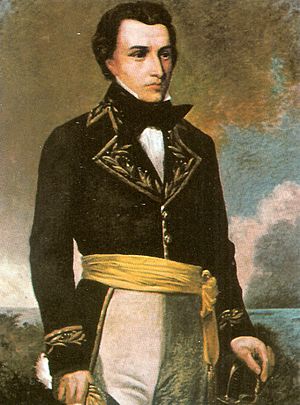Manuel Piar facts for kids
Quick facts for kids
Manuel Carlos Piar
|
|
|---|---|
 |
|
| Born | April 28, 1774 Willemstad, Curaçao |
| Died | October 16, 1817 (aged 43) Angostura, Venezuela |
| Rank | General-in-Chief |
Manuel Carlos Piar (born April 28, 1774 – died October 16, 1817) was a very important general in the army that fought against Spain. This army helped Venezuela become independent.
Manuel Piar was born in Curaçao. His father was Spanish, and his mother was of Dutch and Afro-Venezuelan heritage. Growing up, he faced challenges because of the social rules of his time. He taught himself many languages. When he was 23, he joined the fight for independence. He played a big part in many battles against the Spanish.
Even though he was a successful general, Piar had disagreements with his leaders, including Simón Bolívar. They disagreed about how people of mixed heritage (called mestizos) should be treated after the war. Piar lost his command and spoke out for mestizo rights. He was later arrested and executed in 1817. This was a sad moment in Venezuela's fight for freedom.
Early Life and Background
Manuel Piar's father was Fernando Alonso Piar y Lottyn, a Spanish sailor. His mother was María Isabel Gómez, a Dutch woman of mixed heritage. She was born in Willemstad, Curaçao. Manuel grew up as a mestizo, which meant he faced social limits in colonial times.
When he was ten, he moved to La Guaira, Venezuela, with his mother. He did not go to a formal school. However, he learned a lot on his own. He also taught himself several languages.
At 23, he wanted to help Venezuela become free. He joined a group in 1797 that tried to gain independence. This attempt was not successful.
Military Adventures
In 1804, Piar joined the militia in Curaçao. This group was fighting against the British who had taken over the island. The Curaçao militia won, and the Dutch took control again. By 1807, Piar was in Haiti. He helped their revolution and even commanded a warship.
By 1810, Piar used his military skills to help Venezuela. He joined the fight against Spain. He started in the navy. He commanded a warship and fought in battles against the Spanish navy. One important battle was the Battle of Sorondo in the Orinoco river in 1812.
When the fight was going badly for his side, Piar went to Trinidad for a while. He returned to Venezuela in 1813 as an army Colonel. He successfully defended Maturín. He also helped free the eastern part of Venezuela from Spanish forces.
In 1814, Piar became a Brigadier General. He led troops in the areas of Barcelona, Caracas, and Cumaná. He lost a battle against the forces of José Tomás Boves near El Salado.
Later, he was promoted to Major General. He joined Simón Bolívar in Haiti. They took part in the successful Los Cayos expedition. He also fought in the battles of Los Frailes and Carupano.
In 1816, Piar defeated the army of Francisco Tomás Morales at El Juncal. After this, Piar marched to Guayana. He wanted to free that area. In early 1817, he surrounded the city of Angostura. On April 11, his forces won a big victory. They defeated Spanish General Miguel de la Torre at the Battle of San Félix. A few days later, Piar captured the Capuchin missions in Guayana. He freed Tumeremo. The Spanish soldiers who survived were captured and sentenced to death. This city became a key place for Bolívar's patriot soldiers. A month later, Piar was promoted to General-in-Chief.
Challenges and Final Days
After his military victories, Piar started to have problems with his leaders. These leaders were mostly white criollo people. Simón Bolívar was one of them. This led to Bolívar taking away Piar's direct command of troops. Piar then asked for time off, which was given to him in June 1817.
Piar wanted more than just independence. He also wanted more power, social rights, and political rights for mestizos. He was unhappy with how mestizos were treated by the Spanish. Piar hoped things would be better after the royalists were defeated. But it seemed this would not happen. Piar, who no longer commanded troops, stayed in Guayana. He tried to get support for his ideas. He wanted to challenge the mostly white criollo leadership. Piar was the only leader of mixed heritage.
Other senior military commanders also disagreed with Bolívar. These included José Félix Ribas, Santiago Mariño, and José Francisco Bermúdez. However, they were white-criollos. Their reasons for disagreeing with Bolívar were different from Piar's.
In a sad part of the independence struggle, Bolívar ordered Piar to be arrested. Piar was accused of leaving his post, not following orders, and planning against the government. Piar was the only one arrested. Many believe Bolívar wanted to make an example of one general. Piar was chosen. He was arrested on September 28, 1817. A military court found him guilty. On October 15, he was sentenced to death. On the same day, Simón Bolívar, as the Supreme Commander, approved the sentence. The next day, Manuel Piar was executed by a firing squad. This happened against the wall of the cathedral in Angostura. Bolívar did not watch the execution. He heard the shots from his office nearby. He reportedly said, "He derramado mi sangre" (I have spilled my blood), with tears in his eyes.
See also
 In Spanish: Manuel Piar para niños
In Spanish: Manuel Piar para niños
- Military career of Simón Bolívar

